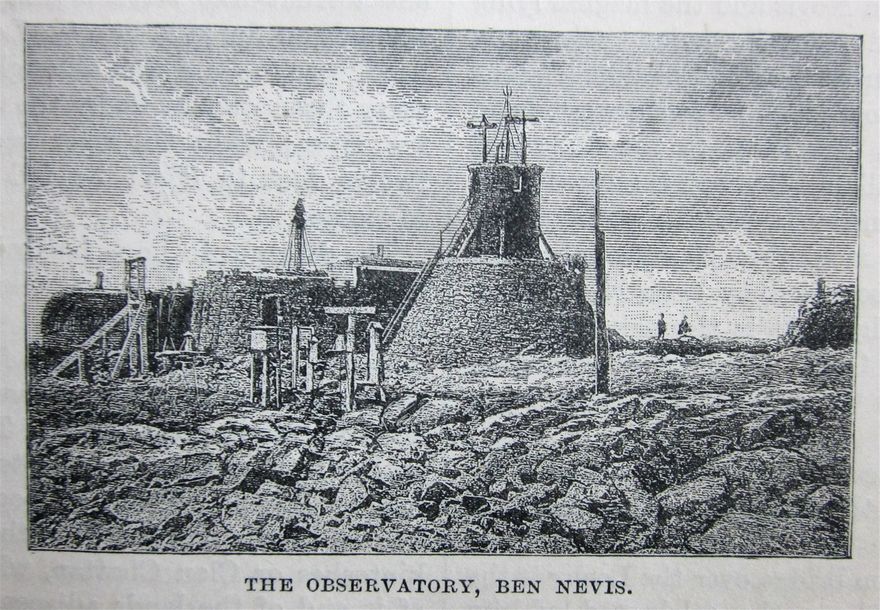An Account of Mr C.L. Wragge, meterorologist on Ben Nevis: taken from Tourist's Guide to the Royal Route..., published by Thomas Nelson and Sons (1901).
Text taken from Tourist's Guide to the Royal Route, 1901:
Weather observations at high levels being greatly valued by meteorologists, it was resolved, in the early summer of 1880, to establish an observatory in this elevated position [Ben Nevis summit]. Mr. C.L. Wragge, the resident observer at Fort William, was placed in charge of it; and from the 1st of June to the 13th of October, a journey was made to it every day, by himself or his assistant, to make careful readings of the instruments which had been erected. In the furious storm that swept over Scotland on the 14th, the canvas roof of the Observatory was swept away by the wind, and the little hut destroyed. On the 27th, therefore, Mr. Wragge considered it prudent to ascend the mountain and remove such of the instruments as could not safely be left for the winter.
The ascent and descent of Ben Nevis for this purpose occupied nearly twelve hours. Attended by an experienced guide, Mr. Wragge left Fort William at half-past six in the morning; the air, though cold, being dry, clear, and exhilarating. At 1,700 feet above the sea-level, he fell in with ground frost and ice, and could see that the upper portion of the mountains was white with snow. At 2,000 feet he reached the snow-limit; and as the atmosphere was still luminous and transparent, enjoyed a magnificent coup d'oeil of snow-shrouded peaks and thunder-stricken precipices, of the verdant valleys below and the sapphire sea beyond. Near the summit bubbles up a pelucid spring, named Buchan's Well, after the Secretary of the Scottish Meteorological Society; this was reached at 8.30 a.m., nearly three hours after starting. It was covered in by a snow-drift to the depth of a couple of feet; but the water underneath was found to be clear and unfrozen, though with a temperature of 28°. Its usual temperature ranges from 36° to 39°. It is worth noting that, at this great height, the climbers discovered the track of a hill-fox in the snow: as they came upon it again, 200 feet higher, the animal had evidently been ascending the mountain. At 4,000 feet they attained the Plateau of Storms, - so called from the hard and strong north-easterly gales which sweep across it, and almost exhaust the strength and nerve of those who attempt the ascent. The summit was finally gained a little before nine o'clock. It lay six inches deep in dry snow of the purest white; and the precipitous declivities to the north-east were also coated thickly with snow, which successive gales had accumulated upon them.
Several hours were laboriously spent in collecting the different instruments, some of which were incrusted with ice three or four feet thick. Three were left behind - namely the barometer, which, with its case, was protected by a large cairn; and the maximum and minimum self-registering thermometers, which Mr. Wragge set for the winter. A little after two o'clock, the descent was begun, and the travellers reached Fort William in safety at five o'clock.
The observations collected by Mr. Wragge during his sojourn on this lofty natural watch-tower proved of so much scientific value that the Scottish Meteorological Society resolved to erect a permanent observatory as soon as the necessary funds were forthcoming. Accordingly, in the summer of 1883, the necessary buildings were constructed, and on the 17th of October the Observatory was opened under the charge of Mr. R.T. Omond. A new tower was raised in 1884. Surely a man must be inspired with the purest scientific enthusiasm who can spend the winter hours amid the snowy solitudes of Ben Nevis!
